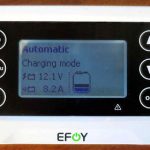
EFOY Comfort 210 installed on Gizmo
Installing an EFOY Comfort could vary a lot from boat to boat, but it’s hard to picture a situation that would be terribly difficult or beyond the skills of a careful do-it-yourselfer (if you want to go that route). All three Comfort models are about 17.5-inches long, 8 wide, and 11.5 tall — “the size of our breadmaker!” a cruiser told me — and the 210 on Gizmo fit easily in an under-settee locker once fully occupied by an AC unit. The space already had the fresh air supply called for in the install manual, so the biggest task for me was hole sawing the main cabin floor to run the 4-inch exhaust hose out of the living space and into the separately ventilated engine room.
The thin “moisture-saturated waste gas” hose — seen above with its gray insulating sleeve — also goes to the engine room along with two wire pairs, one for voltage sensing, the other for charging. You can also see two Cat5 cables, one of which connects and powers the included control panel, the other running to an optional Bluetooth module that can integrate the fuel cell with myEFOY apps. I’ll explain further below why the app is easily worth the slight extra expense and will also detail that fuel canister.
Incidentally, even with this EFOY in my main cabin, and much larger locker vents than show in the photo, I can not hear it running unless the silence is total, and then just faintly.

EFOY fuel cell install details in Gizmo’s engine room
In Gizmo’s engine room below that locker (left above), you’d see the working ends of the exhaust and waste lines, and if you were there when it was running you might detect a slightly bitter odor. Methanolis also known as wood alcohol, so no surprise that the smell is like the alcohol boat stoves you may remember. I have seen a bit of dripping from the waste line, which is why it should be directed to somewhere like the bilges.
While EFOY advised me not to mount the fuel cell itself in the engine room, due to the heat and possible dampness, it could go in a deck locker if a suitable cabin space isn’t available. While I can’t say that I fully understand EFOY’s explanation of the fuel cell process, the wastes seem minimal although I certainly would not ignore this warning:
In exceptional cases, the waste gases emitted by the device may contain substances that are harmful to health!
Do not inhale waste gases directly for prolonged periods. Instead, use the exhaust tube provided to route the waste gas into the open air.
The EFOY 210 came with a fused wiring harness, but I shortened it to minimize voltage loss and used the Blue Sea ST Blade Battery Terminals attached to the bus bars of Gizmo’s Firefly carbon foam AGM battery bank (which is why I’m willing to allow this bank to run down to lower standing voltage levels than normally recommended).


